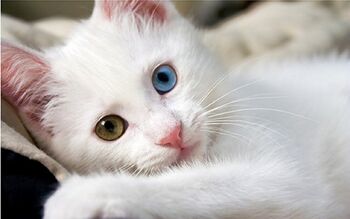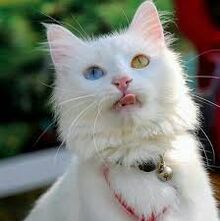
The Van Kedisi, translated from the Turkish language as «Cat of Van», is a distinctive breed of domestic cat that is found mainly in the Lake Van region of Turkey.
It is large, all white, and odd eyed.[1]
History[]
The Van Kedisi has been reported living in the vicinity of the city of Van for centuries, and medieval sources mention white cats as being one of the exports of the Van region.
Characteristics[]
The cats are notable for their lean, long-legged appearance. They are reported to like water more than most cats, and have been seen swimming in Lake Van.
Their most notable genetic characteristic is their almond-shaped eyes that often are mismatched colors. The most valued and valuable members of the breed generally have one amber-green eye and one blue eye. They also reportedly have a genetic tendency to deafness, as do any all-white breed of domestic cats and dogs.
Current status[]

During the late 1990s the Van Cat emerged as an informal municipal symbol of the city of Van – an enormous statue of a Van Cat and kitten now stands at the entrance to the city, and the cat appears in a local comic strip, and in the logos of bus companies, shopping centres, various businesses, etc. Ironically, this paralleled a serious decline in Van Cat numbers.
In the mid-1990s the "Van Cat House", a Van Cat breeding and research center, was established within the campus of Van University (Van Yüzüncü Yıl Universitesi / Van Hundredth Year University). However, reports [1] have revealed that the living conditions for the cats held there leaves much to be desired, and the breeding program seems to be ineffective in reversing the Van Cats’ declining numbers. The center currently (2006) houses about 100 adult, young cats, and kittens, and is open to the public for a nominal entrance fee (currently 1 lira).[2]
At the end of the 19th century, Sultan Abdul Hamid II is said to have owned a Van Cat, and owning a Van Cat is still seen as a status symbol: a Prime Minister of Turkey received one as a gift, and an ambassador from Greece put himself on a waiting list to get one. Kittens for the breeding center could be purchased for $30 in 2006, but their export from Turkey is theoretically outlawed (with a reported fine of $50,000. [citation needed] )
To increase the population of the Van Kedisi, the local government of Van instituted a program which would pay residents the equivalent of $200.00 per month to keep one. This program was discontinued by a later government.
In popular culture[]
The mascot of the 2010 FIBA World Championship, hosted by Turkey, was an anthropomorphic Van Kedisi named "Bascat". He had a white coat and odd eyes, one blue and one green, and his head was altered to take design cues from the crescent moon on the Turkish flag.[3]
See also[]
- Turkish Van - A breed descended from two kittens from the Lake Van region.
- Turkish Vankedisi - A breed name accepted by some cat registries to refer to Van Cats and all white Turkish Vans.
- Van Cat naming controversy
References[]
- ↑ 1.0 1.1 http://newspot.byegm.gov.tr/2006/february/ns11.htm
- ↑ Most of the above information is contained in "Van City Guide", Ankara, 2005.
- ↑ 2010 FIBA World Championship Event Guide: Mascot. FIBA. Retrieved on 2010-09-12.
